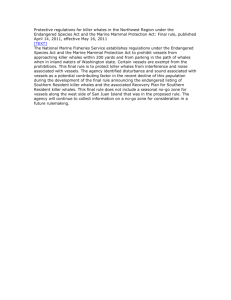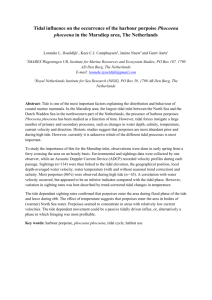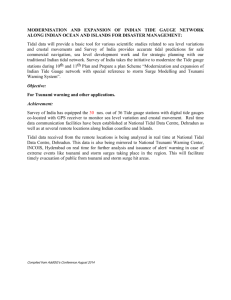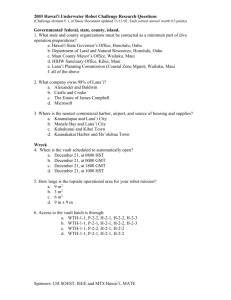finprop_erin
advertisement
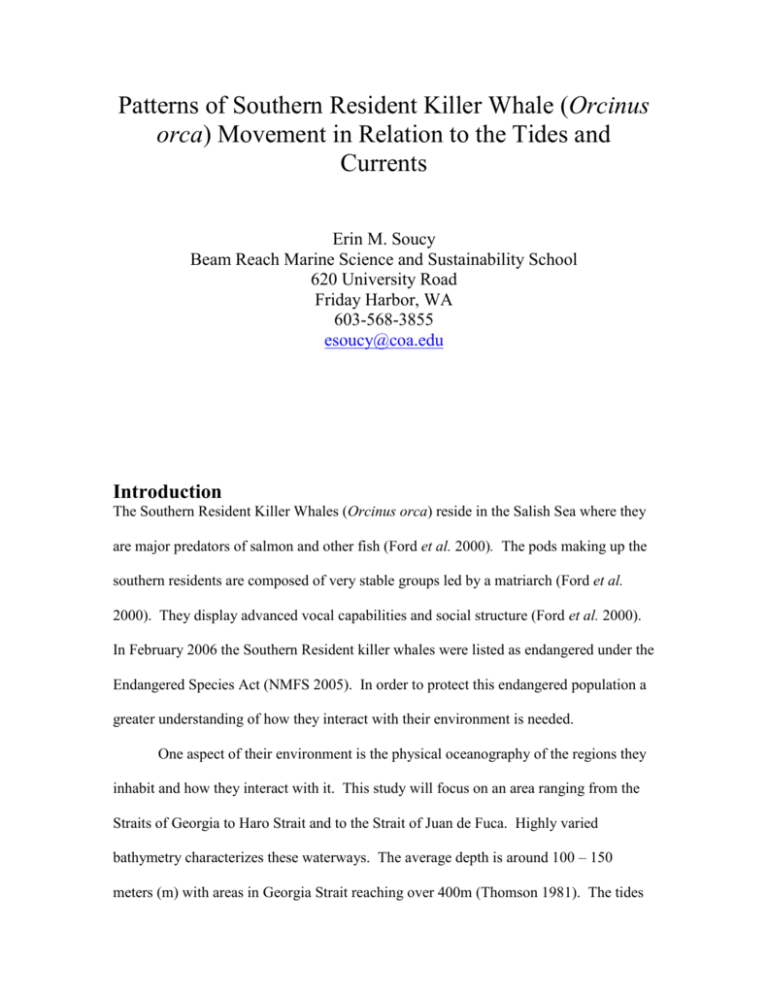
Patterns of Southern Resident Killer Whale (Orcinus orca) Movement in Relation to the Tides and Currents Erin M. Soucy Beam Reach Marine Science and Sustainability School 620 University Road Friday Harbor, WA 603-568-3855 esoucy@coa.edu Introduction The Southern Resident Killer Whales (Orcinus orca) reside in the Salish Sea where they are major predators of salmon and other fish (Ford et al. 2000). The pods making up the southern residents are composed of very stable groups led by a matriarch (Ford et al. 2000). They display advanced vocal capabilities and social structure (Ford et al. 2000). In February 2006 the Southern Resident killer whales were listed as endangered under the Endangered Species Act (NMFS 2005). In order to protect this endangered population a greater understanding of how they interact with their environment is needed. One aspect of their environment is the physical oceanography of the regions they inhabit and how they interact with it. This study will focus on an area ranging from the Straits of Georgia to Haro Strait and to the Strait of Juan de Fuca. Highly varied bathymetry characterizes these waterways. The average depth is around 100 – 150 meters (m) with areas in Georgia Strait reaching over 400m (Thomson 1981). The tides are mixed semidiurnal with two highs and two lows each day of unequal magnitude (Thomson 1981). A study that looked at feeding ecology of the Southern Residents by Felleman et al. (1991) found that the whales foraged more in certain bathymetric regions. They also found that Southern Residents generally moved with the flood and against the ebb current of the tide (Felleman et al. 1991). They found the orcas changed the direction of their travel within an hour of slack tide, seven times more often than would be expected by chance (Felleman et al. 1991). A study in Scotland of coastal dolphins (Tursiops truncates) looked at spatial distribution in relation to the tidal cycle (Mendes et al. 2002). Land based observations estimated dolphin abundance throughout all stages of the tidal cycle as well as dolphin position in relation to the tidal front (Mendes et al. 2002). They found that the dolphins were associated with the tidal fronts and most abundant during the flood (Mendes et al. 2002). Calanus finmarchicus, a copepod, is an important prey item of North Atlantic right whales (Eubalaena glacialis) (Baumgartner et al. 2003). The vertical distribution of C. finmarchicus was measured along with right whale abundance. Right whale sighting rate was correlated with C. finmarchicus abundance and both right whale sighting rate and C. finmarchicus abundance between 90-140m seemed to have a similar periodicity to the tides (Baumgartner et al. 2003). Johnston et al. (2005a) used satellite telemetry, line transect surveys and remote sensing to look at the fine-scale distribution of harbor porpoise (Phocoena phocoena). Line-transect surveys (25 at flood tide and 20 at ebb tide) in a focal region showed that relative porpoise density was significantly higher during flood than an ebb tide phase (Johnston et al. 2005a). Prey surveys showed aggregations of prey along tidal fronts in this region providing a context for the higher densities of porpoise at flood tide (Johnston et al. 2005a). Predators in the marine environment often forage along oceanographic features that result from tidal influence and are common areas of prey aggregations. Over the period of two summers land and boat-based surveys were used to describe the movements of fin (Balaenoptera physalus) and minke (Balaenoptera acutorosrata) whales in an island wake in the Bay of Fundy (Johnston et al. 2005b). That study found that both fin and minke occurrences were highest during flood tides and lowest during mid-ebb phases (Johnston et al. 2005b). In addition sightings of both whales were concentrated in areas of slower current velocity in the area influenced by an eddy system within the island wake (Johnston et al. 2005). A 2001 study set out to determine if harbor seals exhibit tidal patterns in their atsea distribution, abundance and foraging success (Zamon). During the study time seal abundance in the water during a flooding tide was significantly higher than the median daily abundance (Zamon 2001). Large fish capture occurred more often during an incoming tide and the median per capita capture rates were greatest in currents during slow flooding (Zamon 2001). There have been studies looking at how various species interact with the tidal cycle. A general trend seems to be that the marine mammals associate with tidal cycles to follow their prey. The aim of this study is to look for general trends in Southern Resident killer whale movement in relation to the tidal cycle. In coastal ocean areas the tide is a controlling factor in the lives of residents. The Southern Resident orcas spend more time in inshore coastal waters than other Pacific Northwest populations of killer whales; therefore they are likely affected by the cycle of the tide. Perhaps there are energy considerations in moving in relation to the flow of the tide, or maybe they are following food. This study hopes to expand upon the observations made by Felleman et al. (1991) that the Southern Residents were seen to move with the flood and against the ebb of the tide and that they often changed the direction of travel within one hour of slack tide. Materials and Methods The study will be conducted in the waters around the San Juan Islands, WA aboard a 42 foot sailing catamaran as part of the Beam Reach Marine Science and Sustainability School fall quarter. Data will be collected over five weeks in September and October. When we come upon a group of whales we plan to parallel them at no closer than 100 meters. While we are with the whales, a track will be recorded on a Garmin GPS 12XL Personal Navigation device, the goal being that our track will closely follow that of the whales only offset by approximately 100m. At the start of each encounter with the whales the time and the orientation of the whales heading will be recorded as well as a waypoint to indicate where on the ship’s track we met up with the whales. The group will then continuously be observed and any changes in direction and their corresponding times recorded in a field notebook and a GPS waypoint taken. The current information for this study will be taken from Washburne’s Tables and Current Atlas for Juan de Fuca Strait to Strait of Georgia. Strength and direction of general regional currents and tidal state and level will be compared to whale orientation as well as changes in direction. ArcGIS v. 9.1 (ESRI) will be used to overlay the directional whale movement data with the current data to provide a spatial component of whale relationship to tides and currents. List of References Baumgartner, M.F., Cole, T.V.N., Campbell, R.G., Teegarden, G.J., and Durbin, E.G. 2003. Associations between North Atlantic right whales and their prey, Calanus finmarchicus, over diel and tidal time scales. Mar. Ecol. Prog. Ser. 264: 155-166. Felleman, F.L., Heimlich-Boran, J.R., and Osborne, R.W. 1991. The Feeding Ecology of Killer Whales (Orcinus orca) in the Pacific Northwest. Pages 113-147 In Karen Pryor and K.S. Norris, editor. Dolphin Societies. University of California Press. Ford, J.K.B, Ellis, G.M., and Balcomb, K.C. 2000. Killer Whales. UBC Press, Vancouver. Pp 104. Johnston, D.W., Westgate, A.J., and Read, A.J. 2005a. Effects of fine-scale oceanographic features on the distribution and movements of harbour porpoises Phocoena phocoena in the Bay of Fundy. Mar. Ecol. Prog. Ser. 295: 279-293. Johnston, D.W., Thorne, L.H., and Read, A.J., 2005b. Fin whales Balaenoptera physalus and minke whales Balaenoptera acutorostrata exploit a tidally driven wake ecosystem in the Bay of Fundy. Mar. Ecol. Prog. Ser. 305: 287-295. Mendes, S., Turrell, W., Lütkebohle, T., and Thompson, P. 2002. Influence of the tidal cycle and a tidal intrusion front on the spatio-temporal distribution of coastal bottlenose dolphins. Mar. Ecol. Prog. Ser. 239: 221-229. National Marine Fisheries Service (NMFS). Federal Register: Rules and Regulations. Vol. 70, No. 222. 69903-69912. Friday, November 18, 2005. Thomson, R.E. 1981. Oceanography of the British Columbia Coast. Can. Spec. Publ. Fish. Aquat. Sci. 56: 291 p. Zamon, J.E. 2001. Seal predation on salmon and forage fish schools as a function of tidal currents in the San Juan Islands, Washington, USA. Fish. Oceanogr. 10:4 353-366.



